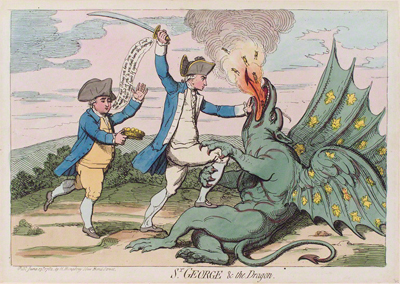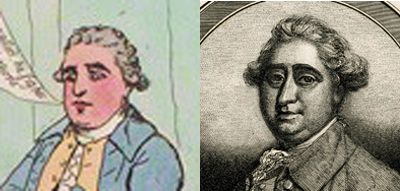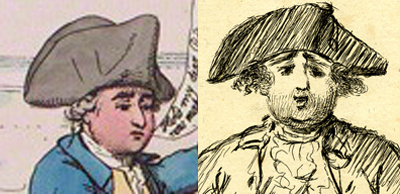St. George and the Dragon
St. George and the Dragon shows "Saint George" (British Naval Admiral George Rodney) delivering a death blow to a clearly French dragon decorated with fleurs-de-lis wings and spouting (French) frogs. Behind him, Charles James Fox is running up to offer a baron's coronet, exclaiming:
Hold my dear Rodney, you have done enough. I will now make a Lord of you, and you shall have the happiness of never being heard of again.

© National Portrait Gallery, London
In April of 1782, Rodney had the misfortune of gaining a decisive naval victory against the French at the Battle of the Saintes while back at home a change of ministry was taking place, making Fox the new Foreign Secretary. Before news of his victory had reached England, a letter of recall had already gone out replacing Rodney with the Whig favorite, Admiral Hugh Pigot. Thoroughly embarrassed by Rodney's victory, Fox and the Whigs were willing and indeed eager to reward him with a Barony and a pension in order to ensure his quick exit from the national consciousness. Gillray was obviously not cooperating in this endeavor.
Gillray's portrayal of Fox was very much in transition at this time. Of twenty-one prints in which Fox plays a part in 1782, sixteen use the old emblem technique in which Fox appears not as a caricatured portrait but as a fox or a man with a fox's head. And even after Gillray's first attempts at portraiture here and in Rodney Introducing De Grasse also in June, Gillray returned to the emblematic Fox in five of the next seven prints.
Not surprisingly, Gillray's caricature portraits of Fox were also evolving. His first portrait of Fox in Rodney Introducing De Grasse may owe something to the mezzotint portrait of Fox by Cosway which had appeared a few days before.

© National Portrait Gallery, London
Detail of Cosway, Portrait of C.J. Fox [1782]
© Trustees of the British Museum
In his next portrait, St George and the Dragon, Fox appears almost cherubic, with a small mouth and virtually clean shaven, closer (at least in the small mouth) to a portrait by Bretherton.

© Trustees of the British Museum
Detail of Bretherton, Portrait of C.J. Fox
A month later in Gloria Mundi... Fox is beginning to assume the darker, jowlier, less clean-shaven image that continues in The Soliloquy [August 1782] and Aside He Turned for Envy... [December 1782] which may have been influenced by Sayers. But he is working his way towards his own portayal of Fox which ultimately became the standard against which all other versions were judged.

© Trustees of the British Museum
Detail of James Sayers, Paradise Lost [1782]
© Trustees of the British Museum
Sources and Reading
- Commentary from the British Museum on St. George and the Dragon
- "George Brydges Rodney, 1st Baron Rodney," Wikipedia
- "Battle of the Saintes," Wikipedia
- Draper Hill, The Satirical Etchings of James Gillray, 1976, #3
Comments & Corrections
NOTE: Comments and/or corrections are always appreciated. To make that easier, I have included a form below that you can use. I promise never to share any of the info provided without your express permission.